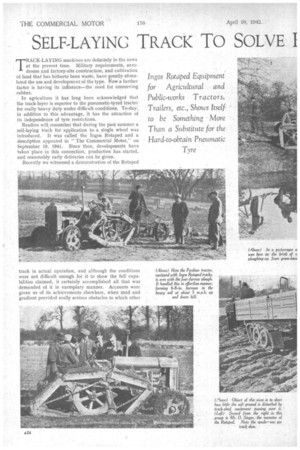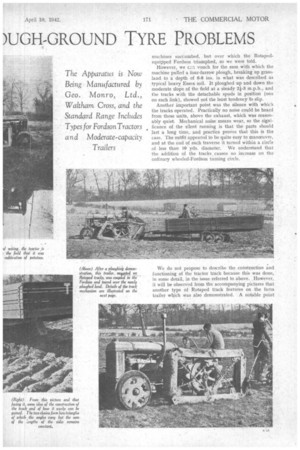SELF-LAYING TRACK TO SOLVE I
Page 26

Page 27

Page 28

If you've noticed an error in this article please click here to report it so we can fix it.
)UGH-GROUND TYRE PROBLEMS TRACK-LAYING machines are definitely in the news at the present time. Military requirements, aerodrome and factory-site construction, and cultivation of land that has hitherto been waste, have greatly stimulated the use and development of the type. Now a further factor is having its influence—the need for conserving rubber.
In agriculture it has long been acknowledged that the track-layer is superior to the pneumatic-tyred tractor for really heavy duty under difficult conditions. To-day, in addition to this advantage, it has the attraction of its independence of tyre restrictions.
Readers will remember that during the past summer a self-laying track for application to. a single wheel was introduced. It was calle-d the Ingos Rotaped and a description appeared in " The Commercial Motor," on September 19, 1941. Since then, developments have taken place in this connection, production has started, and reasonably early deliveries can be given.
Recently we witnessed a demonstration of the Rotaped
track in actual operation, and although the conditions were not difficult enough for it to show the full capabilities claimed, it certainly accomplished all that was demanded of it in exemplary manner. Accounts were given us of its achievements elsewhere, when mud and gradient provided really serious obstacles to which other machines succumbed, . but over which the Rotapedequipped Fordson triumphed, so we were told.
However, we vouch for the ease with which the machine pulled a four-furrow plough, breaking up grassland to a depth of 6-8 ins. in what was described as typical heavy Essex soil. It ploughed up and down the moderate slope of the field at a steady 21-3 m.p.h., arid the tracks with the detachable spuds in position (one on each link), showed not the least tendency to slip.
Another important point was the silence with which the tracks operated. Practically no noise could be heard from these units, above the exhaust, which was reasonably quiet. Mechanical noise means wear, so the significance of the silent running is that the parts should last a long time, and practice proves that this is the ease. The outfit appeared to be quite easy to manceuvre, and at the end of each traverse it turned within a circle of less than 10 yds. diameter. We understand that • the addition of the tracks, causes no increase on the ordinary wheeled-Fordson turning circle.
We do not propose to describe the construction and functioning of the tractor track because this was done, in some detail, in the issue referred to above. However, it will be observed from the accompanying pictures that another type of Rotaped track features on the farm trailer which was also demonstrated. A notable point in this connection is, the small depression of the soil that is caused when it is driven over soft land. In our presence the outfit was taken across the ground that had just been ploughed, and neither trailer nor tractor materially disturbed the newly turned-over surface. An eight-link track and two wheels, the whole being mounted on a single axle, are used in the case of the trailer, whilst instead of chains to control the track links, a system of levers is employed.
The assembly, as supplied for a trailer, comprises a new axle, ready for bolting on the existing springs or main beam, the two track units and the bolts.
Two channels, arranged back to back and spaced apart by welded-on distance pieces, form the axle bed. At each end, between the two channels, is welded-in a length of steel tube.
Considering one side, we find that there is a short shaft passing through the tube and free to turn in it. This shaft is rigidly fixed at its outer end to a rocking beam, whilst it is retained by a collar and taper pin at its inner end. Each end of the rocking beam carries a wheel which runs on roller bearings.
Formed in the rims of the wheels are deep, narrow grooves which engage T-section rails on the track links.\ Each length of rail is welded in position, is spaced about 2 ins, from the link inner face and is off-set.
Freely mounted on the axle, between the rocking beam and the axle-bed tube end, are four double-ended levers, each formed of two steel strips suitably spaced apart. Pinned to each end of each lever is a link, and alternate track shoes have at their centres, on the inner faces, lugs, to each of which are pinned the other eiids of two of thez:,e links.
The device functions on the " lazy tongs " principle, and each shoe lug marks one end of one of the two sets of tongs.
Whatever position, in relation to the axle centre, any point on the track is compelled, by external or internal influences, to assume, the opposite point is held in the corresponding position. Thus, symmetry is at all times preserved, and the movements of the respective links are controlled according to the designer's intentions. Notable in this context is the action of the leading shoe. It swings down in front of the. leading wheel with an angular velocity about its leading hinge axis which diminishes, from a comparatively high figure, to zero as it reaches ground level. This is important, and is associated with the quiet running and longevity of the mechanism.
Another valuable characteristic of the device is that the track of the tractor, although freely hinged, will bridge gullies, and so forth, the unsupported central joint under the wheel being held up by the chains as the wheel passes over it. It seems hardly necessary to mention that each trailer track unit, by virtue of the rocking beam, can accommodate itself to local ground irregularities irrespective of its fellow.
We asked Mr. 0. Singer, the inventor of the Rotaped, what provision was made for lubrication of all the joints and bearings of the trailer assembly. To our surprise he replied: " None; the bearings are glass hard and run dry, excepting, of course, the roller bearings of the wheels which are initially packed with grease." He then detailed the construction of a typical lever joint. A hollow pin expanded at its ends unites the twin members of each radial lever and is externally bushed, hardened steel being used. Working thereon is a hardened-steel outer bush welded to the lazy-tongs end lever. Hardening is carried to a considerable decah and is applied to all wearing parts.
Turning now to dimensions, we understand that the standard trailer assembly has an overall width of 7 ft. 4 ins, to comply with road regulations. Each shoe is 14 ins, long and 10 ins. wide, The production unit is
designed for 3-ton axle loading and, according to whether four or six shoes (counting both tracks) are on the ground, the ground pressure, with this loading, is 12 lb., or 8 lb. per sq. in., as compared with, a pneumatic tyre which watild probably operate at 40-60 lb. per sq. in.
Finally, in answer to our questions relating to production and delivery, Mr. Singer told us that because of the present rubber situation his planned manufacturing schedule had been accelerated and that he could guarantee delivery of trailer-units in about six weeks,
and of tractor-units in 8-10 weeks, adding that orders previously received were now being fulfilled.
The prices are £150 for a pair of track assemblies complete with sprocket wheels for the standard Fordson tractor, and £'40 for the trailer unit, as already specified. Geo. Monro, Ltd., Ingos Works, Waltham Cross, Herts, is the maker.




















































